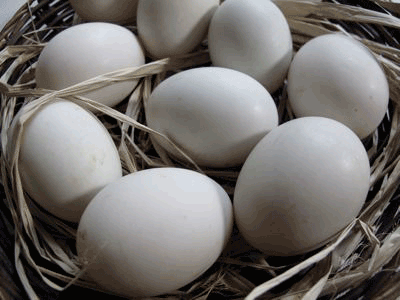How to get luminescent ink from chicken eggs
New method works with many natural carbon sources
By blasting an egg with a plasma beam, researchers have developed a new method for creating luminescent carbon nanoparticles on carbon, also known as carbon dots or C-dots.

Researchers discovered that by blasting a chicken egg with a plasma beam, they can develop the much sought-after carbon dot. (Via: marketmanila.com)
This is an important development because C-dots exhibit excellent optical properties and are also biocompatible. As a result, they are considered better suited for imaging procedures in biosciences than their metal-based semiconductor quantum dot counterparts.
How they did it
The group — Chinese researchers at Nanjing University of Technology — directed a special plasma beam onto a small amount of egg yolk and egg white in order to carbonize the material. After just a few minutes of exposure, the material formed C-dots with a yield of about 6%.
This is considered a major breakthrough in the industry as a ton of processes have been developed in recent years — and failed — in an attempt to develop these miniature objects.
About C-dots
C-dots are not sensitive to acids or bases. When exposed to UV light, they fluoresce a bright blue color (it is understood that their luminescence comes from passivated surface defects that “trap” the excitatory UV light — kind of like an antenna).
When the plasma beam was exposed to the egg yolk, the resulting C-dots formed a crystalline structure of about 2.2 nm; those from the egg white were formless and measured about 3.4 nm. Both contained graphitic structures, though oxygen and nitrogen atoms were also discovered to bind to the surface in different ways, a very good thing as it allows for good solubility in a wide range of aqueous and organic solvents.
Near the end of the C-dot’s life, carbon dioxide, ammonia, and water were all released (mostly just carbon dioxide, though).
What is plasma-induced pyrolysis?
The method the team used to get the C-dots from the egg is called “plasma-induced pyrolysis.” Plasma is a gas whose components have either been partially or completely separated into ions and electrons. As such, it is considered highly reactive and very energetic.
Pyrolysis, meanwhile, refers to the chemical decomposition of organic material by heat in the absence of oxygen.
Knowing this, the definition of the process kind of speaks for itself. Researchers were able to follow the plasma-induced pyrolytic process by means of thermogravimetric analysis and IR spectroscopy, which includes the uncoiling and breaking down of proteins as well as various chemical reactions.
What’s interesting to note is that this whole process is not limited solely to the chicken egg: the team proved that it also works with other inexpensive, natural carbon sources, including sugars, thereby making C-dots far more accessible in terms of being used for the future development of optoelectronic technologies.
Outlook
In their report, the Nanjing group successfully demonstrated the use of these luminescent dots as printer ink; that is, they printed glowing patterns on several different surfaces by both inkjet and silk-screen printing processes.
Furthermore, they found that the addition of small amounts of organic dyes or semiconducting quantum dots allows the color of the ink to be varied. This could be useful, the team explains in their paper, in optoelectronic applications like forgery-proof labeling and sensor applications.
To learn more, you can download their paper, which was published in Angewandte Chemie under the title “Amphiphilic Egg-Derived Carbon Dots: Rapid Plasma Fabrication, Pyrolysis Process, and Multicolor Printing Patterns.”
It is available online (for registered users) via: onlinelibrary.wiley.com ■
Advertisement
Learn more about Electronic Products Magazine





